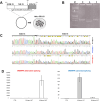A Novel Intronic Variant in the KH3 Domain of HNRNPK Leads to a Mild Form of Au-Kline Syndrome
- PMID: 40304117
- PMCID: PMC12501752
- DOI: 10.1111/cge.14763
A Novel Intronic Variant in the KH3 Domain of HNRNPK Leads to a Mild Form of Au-Kline Syndrome
Abstract
Despite the massive adoption of sequencing technologies, disease-specific diagnosis remains challenging, particularly for genes with highly homologous pseudogenes like HNRNPK. Pathogenic HNRNPK variants cause Au-Kline syndrome (AKS), a neurodevelopmental disorder with malformations and distinctive facial features. We validated a novel de novo HNRNPK intronic variant (c.1192-3 C>A, p.Leu398ValfsTer21) in a patient previously misdiagnosed with Kabuki Syndrome (KS). By combining sequencing, in vitro splicing assays, molecular modelling, and protein function analysis, we characterised the molecular defect. A unique DNA methylation (DNAm) signature was recently identified in AKS, with missense variants showing an intermediate DNAm pattern, suggesting an epi-genotype-phenotype correlation linked to milder clinical features. The DNAm signature is a valuable tool for variant interpretation, especially in unclear AKS cases. We demonstrate that two independent approaches-functional characterisation and DNAm evaluation-confirmed a partial loss of HNRNPK function and validated an AKS diagnosis with a mild phenotype. Our findings highlight that a multidisciplinary approach integrating genomic and epigenomic analyses with functional studies and clinical assessment significantly improves rare disease diagnosis.
Keywords: Au‐Kline; DNA methylation; HNRNPK; alternative splicing; loss of function.
© 2025 The Author(s). Clinical Genetics published by John Wiley & Sons Ltd.
Conflict of interest statement
The authors declare no conflicts of interest.
Figures



References
-
- Au P. Y. B., McNiven V., Phillips L., et al., “Au‐Kline Syndrome,” in GeneReviews, ed. Adam M. P., Feldman J., Mirzaa G. M., Pagon R. A., Wallace S. E., and Amemiya A. (University of Washington, Seattle, 1993). - PubMed
-
- Dentici M. L., Barresi S., Niceta M., et al., “Clinical Spectrum of Kabuki‐Like Syndrome Caused by HNRNPK Haploinsufficiency,” Clinical Genetics 93, no. 2 (2018): 401–407. - PubMed
-
- Yamada M., Shiraishi Y., Uehara T., et al., “Diagnostic Utility of Integrated Analysis of Exome and Transcriptome: Successful Diagnosis of Au‐Kline Syndrome in a Patient With Submucous Cleft Palate, Scaphocephaly, and Intellectual Disabilities,” Molecular Genetics & Genomic Medicine 8, no. 9 (2020): e1364. - PMC - PubMed
-
- Bomsztyk K., Denisenko O., and Ostrowski J., “hnRNP K: One Protein Multiple Processes,” BioEssays 26, no. 6 (2004): 629–638. - PubMed
Publication types
MeSH terms
Substances
Supplementary concepts
Grants and funding
- PE0000006/Italian Ministry for Education, University and Research (MIUR)
- DN. 1553 11.10.2022/Italian Ministry for Education, University and Research (MIUR)
- 20203P8C3X/Italian Ministry for Education, University and Research (MIUR)
- PRIN2020/Italian Ministry for Education, University and Research (MIUR)
- PJT-178315/Canadian Institutes of Health Research (CIHR)
LinkOut - more resources
Full Text Sources
Medical
Miscellaneous

